Let's take you to your preferred destination!
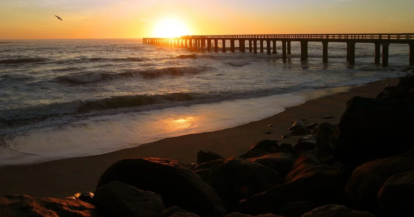
Swakopmund
Situated at the coast, Swakopmund is Namibia’s premier holiday resort. Thousands of Namibians and people from outside the country alike flock to the coast during summer holidays and long weekend. The cool Namibian coast offers a relief from the heat of the interior and this has made it the most preferred holiday destination during summer by most local people.
Swakopmund is an adventure town and recreation is the town’s number one draw card with a wide range of activities to suit all ages. It is well known for sports such as sand boarding, deep sea fishing and beach angling, quad biking, horse riding, hot air balloon and other extreme sports such as sky diving. One thing Swakopmund isn’t boring.
The people of Swakopmund are predominately a quirky mix of German-Namibian residents and German-Germans, who feel right at home with distinctly German architecture and atmosphere. In addition to this, Swakopmund is now becoming a melting pot of Namibian cultures, and you can find people of most of Namibia’s’ 11 different ethnic groups that migrate to the coastal town for employment.
The name Swakopmund is actually a combination of two words from two different tribes namely Nama and German. Swakop, a Nama word means ‘an excrement or opening’ is the name of the river that reaches the sea at the town, while mund is a German word which means ‘mouth’ together meaning mouth of Swakop. The Swakop River during floods collects and transport mud, pieces of vegetation, dead trees and dead animal corpses. This eventually gets dumped into the Atlantic Ocean and to the local people it created a rather unpleasant site rendering the name an ‘excrement opening’.
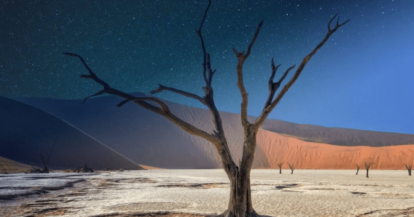
Sossusvlei
Sossusvlei, located in the Namib desert, one of the oldest deserts in the world, is one of Namibia’s most spectacular regions and is perhaps one of, if not the most photographed places in Namibia. Sossus vlei, is a small salt pan, surrounded by sand dunes and the pan itself, together with the surrounding areas is commonly called Sossusvlei. It is Namibia’s scenic highlight situated 65km from Sesriem in the Namib Naukluft Park.
The dunes in Sossusvlei form part of the Namib Sand Sea which was declared a world heritage site by UNESCO in 2013. The sand was transported by the Orange River in Lesotho and South Africa during flash floods millions of years ago, and was deposited at the mouth of the Orange River south of the Namib Desert. The cold Benguella currents of the Atlantic Ocean then moved the sand northwards along the shoreline. Then the tides brought the sand onto the shore and the wind blew it inland some 60, 000 million years ago. The spectacular red color of the dunes these days, is the result of the high iron content in the sand that changes the color through an iron oxidation process over years.
The name Sossus literally means ‘a place where water collects’ and vlei is an Afrikaans word for ‘pan’. Although this only happens once in every five years after good rains, the vlei or pan when filled with water by the ancient Tsauchab River, turns into spectacular lake flanked by ruddy and sparkling red dunes around it. The pan retains water for a long time due to the high clay content and this attracts a large number of tourists as it is such an unusual sight. Nearby Sossus Vlei is Dead Vlei which means ‘dead marsh’. Surrounded by some of the world’s highest dunes, some of which reach over 400m in height, this area is a photographer’s paradise. Once, like Sossus Vlei, the Tsauchab River, that once nourished the trees in Dead Vlei some 9000 years ago, was cut off by the sand dunes as the climate changed. Dead Vlei soon became dry and as a result the acacia trees died. The trees now stand in Dead Vlei simply scorched black in the sun, desiccated rather than petrified. These dead trees are said to be more than a 1000 years old and they form a barren forest which make for stunning photography.
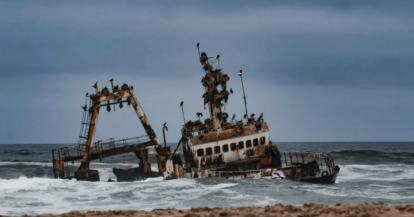
Skeleton Coast
Without a doubt, just hearing the words Skeleton Coast invokes images of some of the world’s most dramatic landscapes and this is with good reason. This incredibly vast coastline stretching all the way from Angola in the north to the border with South Africa in the south with the northern Namib Sand sea covering around 16,000 km₂, lying within the infamous Skeleton Coast National Park.
Namibia’s Skeleton Coast is aptly named due to a combination of whale bones and shipwrecks that litter the coastline. The harsh nature of the cold Benguela current that pushes up from Antarctica are famed for its thick fog and unfavourable sailing conditions as the cause of shipwrecks not only from hundreds of years ago, but even as recently as 2007 when the Zeila wrecked just south of Henties Bay.
In addition to being the graveyard of ships and whales alike, the harsh conditions on the Skeleton Coast make for the perfect environment for Namibia’s national flower, the Welwitschia Mirablis, that thrives in this unique environment.
In terms of fauna, Namibia’s Skeleton Coast is home to the Cape Fur seal, and the Cape Cross Seal Colony is one of the world’s largest colonies of the Cape Fur seal with up to 200,000 seals that can be found during their breeding season (November – December), a sure sight and smell to behold. With the incredible population of seals scattered all along the coast brings hungry predators to the coastal areas and sightings of the famed desert lion and brown hyena are not uncommon in the northern parts of the coast.
While the southern reaches of the Skeleton Coast in the Namib Desert is technically not as accessible due to the fact that there is no road along the coast, it’s certainly no less dramatic as a landscape. Where some of the Namib desert’s largest sand dunes descend straight into the Atlantic Ocean a sight that needs to be seen to be believed. If time & wallet permits, a 4×4 adventure to Sandwich Harbour or a scenic flight along the Skeleton Coast are both highly recommended.
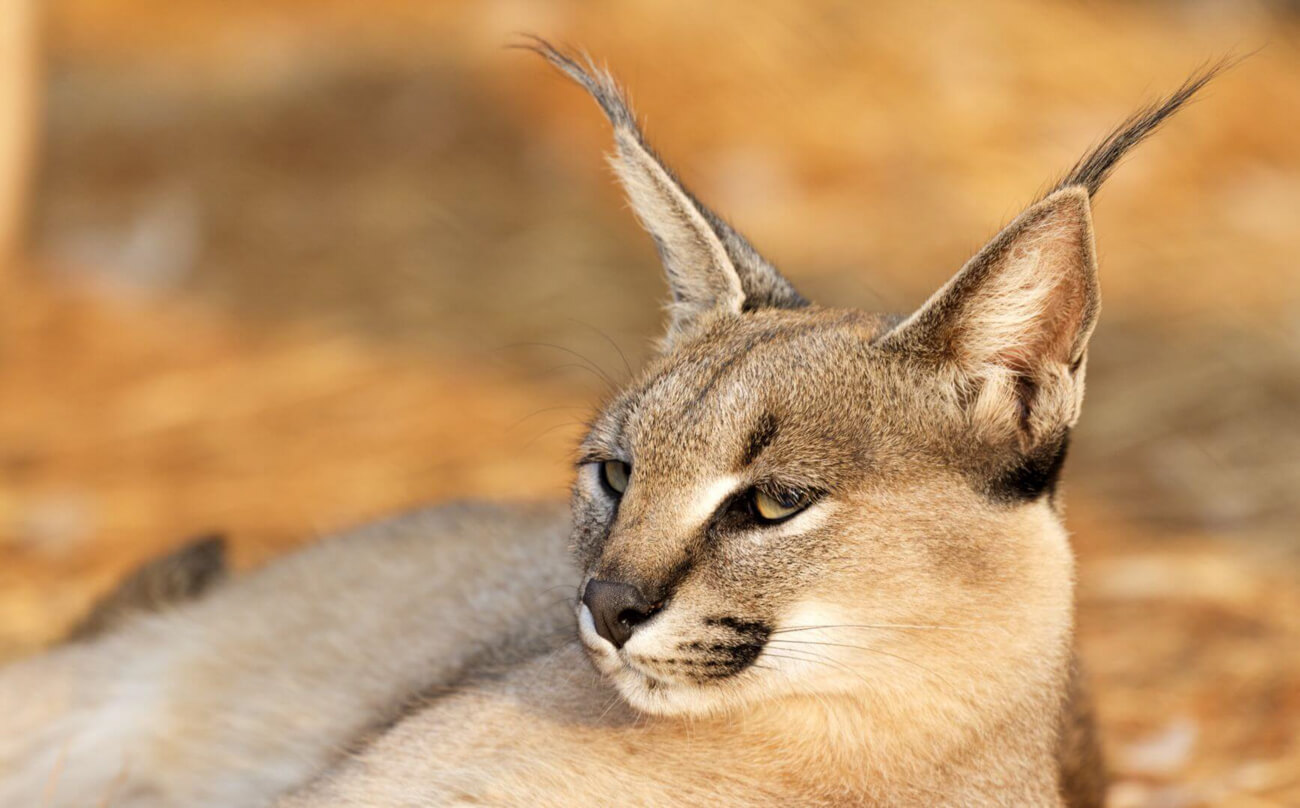
Naankuse Wildlife Sanctuary
The internationally acclaimed N/a’ankuse Wildlife Sanctuary was set up in 2007 to care for Namibia’s orphaned, sick, injured and abused animals, from predators to primates and everything in between and at any one time you can expect to encounter anything from baboons to cheetah to lion to aardvark and more.
N/a’ankuse aims to rehabilitate and release all animals that come to the sanctuary, however for those that can’t be released they provide a safe and secure sanctuary to enjoy the rest of their life. From humble beginnings, N/a’ankuse has gone on to become one of Namibia’s, and the world’s most well-known wildlife sanctuaries with the addition of the Shiloh Wildlife Sanctuary, established in 2017 to care for orphaned and injured rhino and elephant through funding from the Jolie-Pitt Foundation, loyal supporters of N/a’ankuse.
The sanctuary is run on a day to day basis by a dedicated team of conservationists, with the help of a team of volunteers to make sure all animals are fed, monitored and enclosures kept clean to name a few jobs.
N/a’ankuse, which means ‘god will protect us’ in the local San Bushman language, also aims to assist and benefit the often-marginalised San (Bushman) people of Namibia through the Clever Cubs School offering free private primary education, the LifeLine Clinic offering medical assistance to the Epukiro community as well as offering employment and training at N/a’ankuse to the San community.
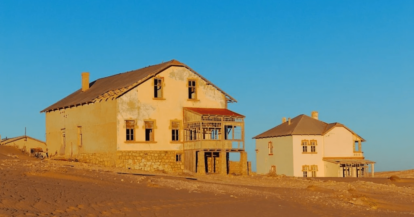
Kolmanskop
Nestled in Namibia’s far south-western corner, the once bustling town of Kolmanskop, once the richest town in Southern Africa, lies semi buried in the sands of the Namib Desert.
Back in 1908 a single diamond was found lying in the sand along the railway at Gratsplatz and this sparked 40 years of diamond mining in the area by the then German empire who were ruling at the time. The discovery of diamonds brought immense wealth to the small settlement and Namibia’s diamond boom began.
With the addition of modern amenities such as a hospital complete with an X-ray machine (the first in the southern hemisphere), ballroom, a skittle alley and a power station all built in traditional German architecture, it’s no wonder that this now abandoned ghost town draws much attention by all that visit Namibia.
In the mid 1950’s as the diamond fields around Kolmanskop were depleted, the Germans moved further south to new and abundant mining areas leaving their luxury homes abandoned. Some 70 years later, Kolmanskop is now a major historical site and tourist attraction as the sands of the Namib have completely encroached the town, including the homes and shops and the luxury that once was, is barely recognisable. Tours of the town are a must as a local guide shows you through the once prosperous town, and regales stories of the wealthy residents as well as those miners who attempted to smuggle diamonds out of the mines.
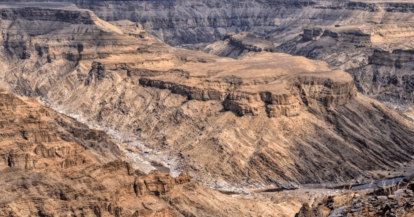
Fish River Canyon
One of southern Namibia’s major attractions is the Fish River Canyon, the 2nd largest canyon in the world. Stretching some 160kms long, and up to 550m from rim to floor at it’s deepest, it is a spectacular landscape to behold. Formed by water erosion and the collapse of the valley due to movements in the earth’s crust over 500 million years ago, the walls of the canyon show incredible geological variations due to the length of time the canyon took to form.
Approaching the canyon viewpoint from Hobas, the main campsite in the area, you can be forgiven for wondering if you’ve driven in the wrong direction as the canyon remains out of sight until you are on the edge. From here, prepare to be awe struck as you stand on the edge and appreciate the sheer magnitude of this incredible formation.
The area is also incredibly rich in wildlife, and whilst this might be surprising due to the apparent lack of grazing in this rick terrain, creatures such as Hartmanns mountain zebra and klipspringer thrive in this area so keep your eyes peeled as they do tend to camouflage incredibly well. It is also a haven for birdlife, everything from the African fish eagle to the Goliath Heron to Black stork and more.
A popular hiking route, the Fish River hike is a 5 day 80kms hike from Hobas to Ai-Ais only accessible during the dry season. This is a grueling hike during the winter season when temperatures can drop below 0 degrees Celsius, however due to the risk of flash flooding during the rain season this is the safer time to enter the canyon. Permits and pre-bookings are required with the hike booking out up to 1 year in advance.
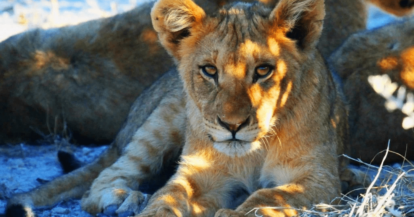
Etosha National Park
Etosha National Park, located in the northern part of Namibia, is one of Southern Africa’s premier wildlife reserves. Covering an area of 22,270km², the park is home to an impressive 114 species of mammals and over 340 species of birds including the big 4 (lion, leopard, rhino & elephants) as well as a plains game like zebra, antelopes, small predators. In addition to these, you can also find species that are endemic to northern Namibia such as the Black-Faced Impala and the smallest antelope the Damara Dik Dik.
Given the parks geographical location being situated between two great deserts, the Namib & the Kalahari, the wildlife of Etosha relies heavily on man-made water holes. During the dry season, these waterholes, like many human waterholes, attract a variety of species which is any photographers dream. The views of elephants, giraffes, lions, hyenas, springbok, zebra and more all drinking together in order to survive the dry winter is something that you don’t see in many other parts of Africa.
The park itself is named after the impressive Etosha Pan, a saline desert stretching 4,760km². Once a shallow lake, this was a wetland habitat for many bird species. These days however, Etosha Pan is a vast expanse of nothing that fills with water approximately every 7 years. This occasion brings with it an incredible sight as close to a million great white pelicans, flamingos and chestnut-banded plovers migrate to Etosha for breeding.
Vegetation in the park varies from tree and shrub savannah to woodland areas which are dominated by Mopane trees, thus ensuring that there is a variety of wildlife and ideal for any avid game enthusiast.
Etosha is the prime location for safaris in Namibia, and always manages to exceed expectations.
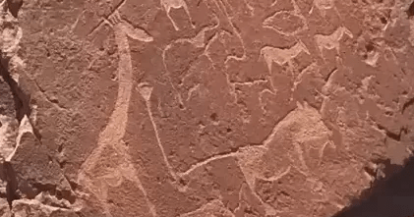
Bushman Rock Art
The San, or Bushmen as they are commonly known, are believed to be THE indigenous people of Southern Africa. The San lived in harmony with nature and followed the migration of animals from time to time, over thousands of years. Wherever they lived, they left no trace of their presence except for the remarkable stories on their rock shelters. The paintings, drawings, or images engraved on the rocks are commonly known as rock art.
The Bushman rock art is found everywhere in Southern Africa and Namibia is no exception. Some of the well-known rock art sites in Namibia include the Spitzkoppe, Brandberg and Twyfelfontein.
The Twyfelfontein area is renowned for some of the best examples of Bushmen paintings and rock engravings in southern Africa. The paintings are usually found on walls of rock shelters or caves formed in cliffs in mountain of the country. These artworks where created by removing part of the rock surface by abrading, carving, incising or pecking. This area became Namibia’s first UNESCO world heritage listed site back in 2007.
Spitzkoppe is also described as the Matterhorn of Namibia and is situated between Usakos and Swakopmund. Forming part of the Spitzkoppe mountain range is the bushman paradise cave which houses one of the finest collections of rock art in Namibia. This cave has been known to Europeans since the beginning of the 20th century. Unfortunately some of these paintings today are badly damaged due to vandalism. The bushman rock paintings at paradise cave were proclaimed a national monument on 1 July 1954.
At the Brandberg, Namibia’s highest mountain there are more than 1000 known rock shelters that houses in excess of 45,000 individual paintings of animal and human drawings (glyphs). The most popular around Brandberg is the White Lady painting believed to be more than 25,000 years old. The Brandberg became a national monument on 3 October 2002.
The white lady bushman painting of Brandberg as well as the bushman rock art of Twyfelfontein are both managed by the Namibian Heritage Council and an entry fee is payable on your visit. For those interested in rock art, Brandberg and Twyfelfontein are a must.
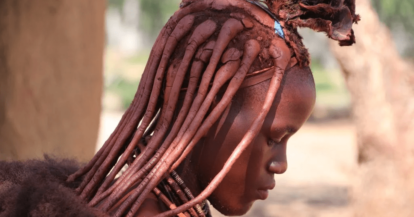
Cultural Experiences
Namibia is incredibly culturally diverse, with 11 different ethnic groups from the San people, one of the worlds oldest cultural groups to the Himba people, to the Nama people in Southern Namibia and the Owambo people in Northern Namibia to name a few. Cultural interactions are a major draw for many visitors to Namibia, and whilst some of our cultural groups are more intriguing to our visitors they all have their own distinct traditions, language and customs that are worth taking the time to get to know.
The North Western region of Namibia, also known as Kaokoland, is home to the nomadic groups of proud Himba people who still choose to live a nomadic and traditional lifestyle. The Himba are semi-nomadic pastoralists characterized by their proud yet friendly bearing. The Himba are easily identified by their very unique appearance, and are one of the most sought after tribes for cultural interactions because of their resistance to modernization.
The San, also known as the Bushman people are hunters and gathers that have the most intricate understanding of living off the land. This knowledge has that has been passed on from generation to generation for the last 20,000 years and this couldn’t be more evident than the incredible collection of rock art, both paintings and etchings scattered across Namibia. These days, the San people are found scattered through the Kalahari Desert in both Namibia and Botswana, and continue to try and survive in the modern world whilst trying to retain their traditions and culture.
The Owambo people are Namibia’s dominant cultural group, coming from Owamboland in the north of Namibia on the border with Angola. This region is littered with traditional villages and the whilst many young Owambo people thrive in modern day Namibia, they still retain their cultural identity and traditions and return to ‘the north’ often to partake in traditional events like planting, harvesting, weddings and funeral. The Owambo people are known for their unique traditional foods, particularly mopane worms and Owambo spinach so make sure you make time to give them a taste if you get the opportunity.
The Herero people are easily identified in their traditional dress with the women wearing bright heavily layered dresses inspired by missionaries from the early 1900’s with a headdress inspired buy their most prized possession, their cattle. Mostly found scattered through central Namibia, the Herero people are pastoralist and like the Himba, their wealth is measured in cattle.
The Nama people of southern Namibia are of Khoi Khoi descent and share many similarities with the San people, their lighter complexions and their linguistic roots, speaking with clicks that quickly stirs interest for foreign tourists. Similar to the Herero women, then Nama women radiate in their brightly coloured traditional dresses.
The Damara people, similar in language to the Nama, come traditional from Damaraland in the north west, in communal lands that are famed for their free roaming wildlife. The Damara people share a language with the Nama, although their traditional lands a fairly separate it’s not really known how this came about. These days, more than 75% of the Damara population have moved into urban areas to seek education and employment.
The Kavango people of Namibia are closely related to the Owambos. Their traditional lands are around the Rundu area, where they make a living from a mix of cattle farming, fishing as well as wood carving. Much of the wooden souvenirs found in Namibia come from this region of Namibia.
The Baster people of Rehoboth identify as a unique tribe, and are proud of their interesting cultural heritage. A mix of Nama and German heritage, this tribe started with many babies being born to Namibian women and German soldiers. As these relationships weren’t something the Germans were openly proud of at the time, the children were born out of wedlock and hence the name stuck. After 100 years of settlement in Rehoboth, the Baster people are proud Afrikaans speaking Namibians who still call the Rehoboth area home.
Originating in the Cape Province of South Africa, Namibia’s Coloured community shares many similarities in terms of appearance and language, both speaking Afrikaans, with the Rehoboth Basters. They are a people of mixed race, who struggled to find their place during the apartheid era as they weren’t included by either the black community, or the white Afrikaans community. These days, they reside mostly in the big cities of Namibia with no real traditional homeland.
The Caprivians, like the Kavangos, are considered to be river people, residing in the far north east of the country, in the now named Zambezi region. Their main source of income comes from both cattle farming and fishing. Making up the smallest cultural group is the relatively small community of white Namibians, comprising of a mix of Afrikaans, German and English speaking Namibians. Mostly found in major cities such as Windhoek and Swakopmund and running a large majority of private companies in central Namibia.